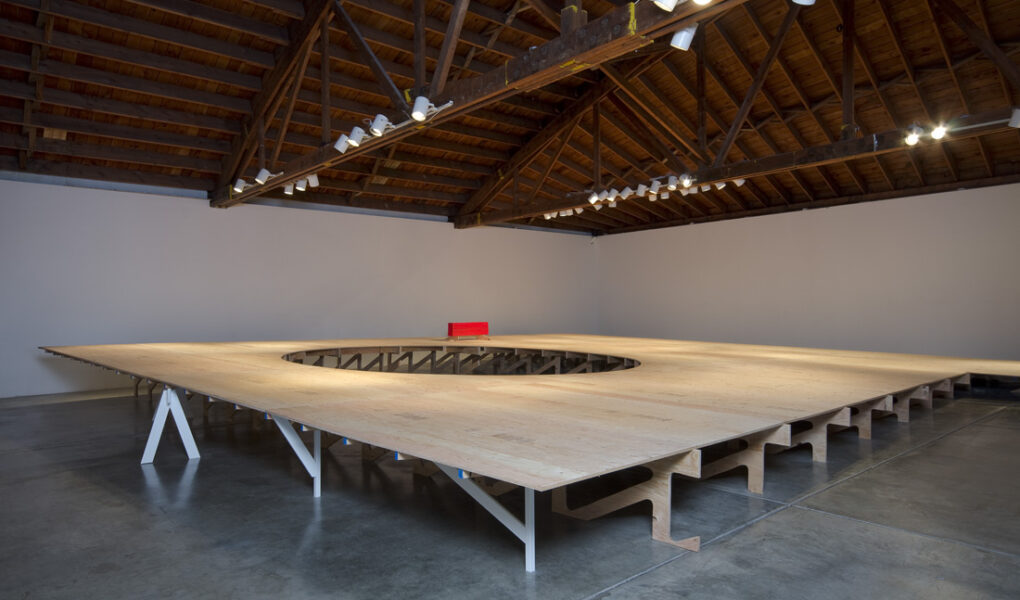Originally published May, 2011
Ingress: Karl Burkheimer’s In Site at Disjecta
By Lisa Radon
Ways in and ways out recur in Karl Burkheimer’s sculptures: ramp, hole, ladder, stair. Finely crafted purified forms in relatively humble materials-unfinished wood, often plywood-Burkheimer’s works invite the viewer in as well with their human scale, suggesting something with which the body might interact. At Open House, a temporary exhibition he curated with Michelle Ross in 2009, his table-like work made of scrap wood had a circular hole through the table top like a lens to the floor. At the Call + Response exhibition at the Museum of Contemporary Craft, Burkheimer’s open box-like sculpture, “Proximate,” had both a circular “window” and perfectly cut square holes…just the right size for a hand, in the floor. These small square holes and one large circular hole reappear in Burkheimer’s latest installation, “In Site,” at Disjecta, the construction of which was supported by a $1,500 Oregon Arts Commission Career Opportunity grant to the artist. This time, the installation is massive, making the square holes almost imperceptible, and the circular hole has grown to crater size.
Much of installation art claims that it is about challenging or at least nudging the viewer’s perception of space or the space in which it’s sited. Karl Burkheimer’s installation, “In Site” does more, forcing us how to consider how we move in a space. If we catalogue the movements we might make while viewing a typical installation, we will likely stroll slowly to different positions around the room, stop and look, look around and move slowly to another position. We rarely have to ask ourselves, how should we interact with this installation? We are meant to look and look only from a variety of perspectives. But “In Site,” for all its tranquility, forces us to decide how we’ll interact with it because it takes up nearly the entire L-shaped main gallery space at Disjecta leaving only a walking path around the walls while offering the invitation of a ramp onto its stage-like plywood surface with a large circular hole in its center and a red wood beam fragment punctuating the blond expanse. Walk up the ramp and “In Site” folds you into the work of art while offering the soundtrack of your feet on its hollow surface. Skirt the piece, moving along the walls, and feel how it almost crowds you out of the space, you who have refused its invitation. Is it criminal for me to compare this tranquilly majestic work to a mullet-all business up front and a party in the back-the calm surface supported by a beautifully crafted truss-like support system with curved cuts of solid plywood. This attention to the unseen is a hallmark of Burkheimer’s work that is conscious of its craftedness, but in a subtle not showy way. Oregon College of Art and Craft is lucky to have him as Wood Department Head, as his high craft aesthetic combines with a compelling ongoing exploration into variations of object as human-built structure (shelter, platform) and prop (stool, bench, ladder). It’s fitting that at Disjecta, the way the body interacts with structure and prop and space was enacted in three performances by three Portland dancers and a cast of dozens moving on, around, and under the sculpture. When Anna Halprin visited Portland last year, the great West Coast dance pioneer suggested in a workshop that the participants move throughout the space with an awareness of the dimensions and features of the space, noticing with the body the height of the ceiling, the corners and doorways. And one does move differently, attuned to a space-especially one altered in such a quiet but dramatic way as Burkheimer’s “In Site”-and perhaps walks out with a hyperawareness hangover (in a good way) that alters our next encounter with the human-built.
Courtesy of The Oregon Arts Commission.
Artist Credit: Karl Burkheimer
